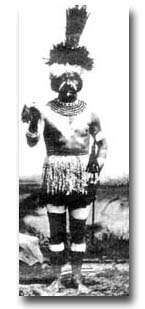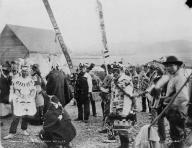
Lecture C) CHIEFDOMS:
Chiefdoms consist of tens of thousands to hundreds of thousands of people living in towns, villages, and hamlets. Usually agriculture is necessary to sustain such numbers. With agriculture, people become completely sedentary. Only in very rich environments can a chiefdom exist without agriculture.
Examples of chiefdoms that do not use agriculture include the North West Coastal cultures, such as the Tlingit and the Kwakiutl, and central California groups, like the Chumash. At the time of contact these cultures were traditional chiefdom level societies. Today these cultures are still chiefdoms, but are organized a bit differently. They still have a hierarchy of leadership, consisting of councils of elders. But, due to land theft, these leaders make decisions regarding traditional land rights relative to the dominant culture. Decisions are made on how to preserve and gain control of traditional lands and cultural resources. The civil rights of Native Americvans, including fishing rights and religious freedoms, are the modern issues that these chiefdoms now face.
With Chiefdom level complexity we start to see highly specialized occupations. People are not taking care of all of their own subsistence needs directly. They are specializing in a trade, such as pottery manufacture, and obtaining the rest of what they need through barter. Chiefdom societies often have developed a form of currancy to make trading more convenient and standardized the values of trade items.
For the Chumash of California, currency was made from ollivela shells. This currency was traded far and wide and is found in sites in New Mexico and beyond. The length of the string of beads determined its value. This currency is no different than paper money we manufacture.

Since leaders in a chiefdoms are full time, they depend on lower status individuals for their food. Their status is not only achieved, but in some cases also ASCRIBED. Ascribed status is when you are born into a social position rather than earn it.
 These full time leaders are also specialized in the jobs that they do. There may be a spiritual leader, an economic leader, a military leader, and a secular leader. There is a hierarchy of leadership as well. There may be leaders who are in charge on one village. Others above them in charge of a group of villages, and one chief who oversees the entire culture. Military leaders will be organised by their ranks, and economic leaders by their industry.
These full time leaders are also specialized in the jobs that they do. There may be a spiritual leader, an economic leader, a military leader, and a secular leader. There is a hierarchy of leadership as well. There may be leaders who are in charge on one village. Others above them in charge of a group of villages, and one chief who oversees the entire culture. Military leaders will be organised by their ranks, and economic leaders by their industry.
Spiritual leaders will also organize hierarchically. There will be leaders who mentor initiates and have decision making powers. There may also be spiritual specialization, with some shamans focusing on initiation rites and others taking care of funerals.
Spiritual needs of the chiefdom will be meet through GROUP CULTS. Group cults deal with the spiritual needs of several individuals at once. Although Shamans are generally dealing with illness and rituals a group at a time, each participant within the group still has a very active role in th e rituals.
Groups cults in various cultures often involve around a dozen individuals at a time. When a group of any kind gets beyond 13 individuals or so, the importance of each individual to the group starts to fade. We start to lose track of the individuals once we get beyond this number. That is why many group cults and other affiliation stay around 12-13 people. A witches coven is generally 13, Jesus and the disciples was 13, and even non-religious groups, such as a judge and jury, consist of 13 people.
A group cult may be a permanent group, such as a group of hunters who perform hunting magic. It may also be a temporary association where a group comes together to solve a specific, transient, problem.
As with secular leaders, religious leaders may be determined through ascribed satatus. In archaeology we determine whether a past society acknowledged achieved or ascribed status by looking at burials of infants and children. If we find some infant/child burials containing relatively large amounts of grave goods, then we can assume that there was ascribed status. This is for the simple reason that babies have not had enough time to achieved status. Any status they have over other individuals in the group must have been ascribed.
In addition to ascribed status, in chiefdoms we see significant stratification and differential access to resources. There are leaders with accumulated wealth, and merchant and worker classes. Very often this inequity comes with some method of the REDISTRIBUTION of wealth, rather than the reciprocity we see in bands and tribes. In our culture taxes and social programs are supposed to redistribute wealth. For Native American chiefdoms redistribution often took the form of potlatches.
Potlatches are huge feasts where the wealthy would demonstrate their wealth and generosity by lavishing food and other goods on their guests. This was and is a common practice in the Northwest Coastal groups. The chiefdoms that held potlatches include the Tlingit, the Haida, Chilkat, and the Kwakuatl. Although potlatches were made illegal by local goverments for many years, they are now a protected civil right.

 |